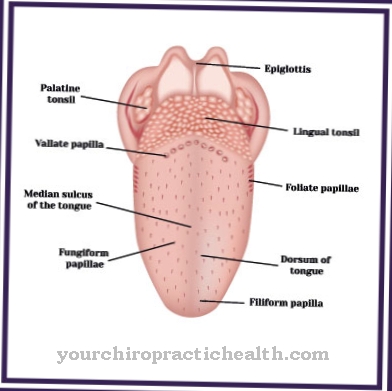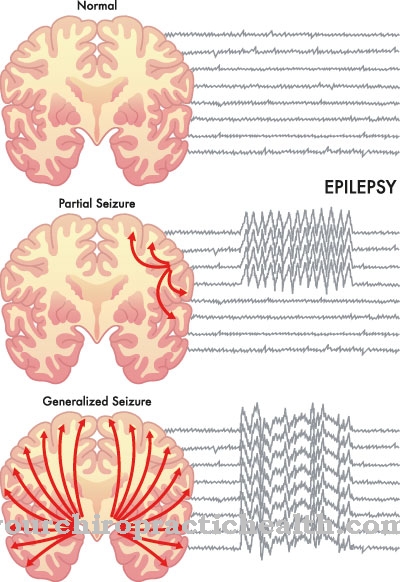The ATR-X syndrome is a very rare congenital disease that only occurs in male patients. Characteristic of the ATR-X syndrome, which is based on genetic mutations, are developmental delays and physical malformations.
What is ATR-X Syndrome?

The ATR-X syndrome is also under the term X-Linked Alpha Thalassemia - Mental Retardation Syndrome or ATR, Nondeletion Type known. This chromosomal disease was first described in 1990 by the British physician Andrew O. M. Wilkie. This syndrome has been recorded in fewer than 170 patients worldwide.
According to the classification of the ICD-10, the ATR-X syndrome belongs to the D56.0 alpha thalassemia and thus to the diseases of the blood and the blood-forming organs, as well as certain disorders that involve the immune system. Most cases of ATR-X syndrome can be found in the Mediterranean region, particularly the Arabian Peninsula and parts of Africa.
It is noteworthy that due to the deformed red blood cells, the malaria virus cannot dock onto it, which is why it is possible that the disease originally served a different purpose.
causes
The ATR-X syndrome is transmitted by inheritance. Since this is X-linked recessive, the syndrome can only occur in male patients. Female persons can only act as transmitters, whereby there are no physical or mental expressions here. ATR-X syndrome is due to a genetic mutation.
This takes place in the ATRX gene on chromosome Xq21.1. The mutation of the chromosome causes changes in the methylation pattern of the DNA in the heterochromosomal areas. However, it is still not known what the clinical appearance is based on.
Symptoms, ailments & signs
The ATR-X syndrome manifests itself shortly after birth in newborns. It is associated with severe retardation in mental physical development. Externally, the chromosomal defect manifests itself in more than 90 percent of patients as dysmorphic facial features and anomalies in the genitals.
But also skeletal abnormalities, microcephaly, short stature, heart defects and kidney and urinary tract malformations can occur more frequently. At first glance, the sagging face is noticeable, in which the mouth area with the typical protruding lower lip is particularly pronounced. A large eye relief with a characteristic inner, sickle-shaped eye crease and a flattened bridge of the nose that merges into a small snub nose complete the morphological appearance of the ATR-X syndrome on the face.
In 80 percent of the cases described, the genitals are characterized on the one hand by a lack of testicular descent, but on the other hand they can be pronounced as intersexual genitals. Cerebral seizures have been described in a third of patients diagnosed with ATR-X syndrome. The patient's ability to speak is severely restricted and there are moderate to profound learning difficulties.
Although there are personal ties to the caregivers, autistic behavior is not uncommon among those affected. Alpha-thalassemia - a disease of the red blood cells in which there is an excess of gamma and beta globins - can be read off from the blood count in some patients.
Diagnosis & course
The confirmed diagnosis of ATR-X syndrome is based on evidence of alpha thalassemia. To do this, the venous blood is examined using a light microscope to detect red blood cells with HbH inclusions. It should be noted that in very many cases the levels of HbH are too low for reliable evidence and the hematology can be surprisingly normal despite a pronounced phenotype and a prevalent family history.
In addition, the doctor detects the pathogenic gene mutation and analyzes the ATRX protein to prove the disease. The total of 168 patients described resulted in 25 deaths, 19 of which were under the age of five. Unfortunately, since there are no long-term studies available, no long-term prognosis for the course of the disease can be made.
Today, patients are in their 30s and 40s and are in good, stable health. About ten percent of patients who have been shown to have ATR-X syndrome live completely symptom-free for up to 40 years.
When should you go to the doctor?
The ATR-X syndrome is congenital and is therefore usually recognized after birth or during examinations by a pediatrician. A causal treatment of the ATR-X syndrome is not possible. However, parents should carry out regular examinations and have the individual symptoms treated so that complications and consequential damage do not occur in adulthood.
As a rule, those affected suffer from severely delayed development. Above all, mental development is delayed. If the parents notice that it is difficult for the child to learn and act, an examination must be carried out by a doctor. The short stature is also a symptom of the ATR-X syndrome and must also be examined. It is not uncommon for language skills to be restricted and language defects to arise.
To avoid bullying or teasing at school, these symptoms should be treated with a doctor. Because patients with ATR-X syndrome have learning difficulties, these children may need to attend special facilities in order to receive proper support. Furthermore, various therapies can make everyday life easier for those affected and should be carried out in any case.
Doctors & therapists in your area
Complications
ATR-X Syndrome or X-Linked Alpha Thalassemia Mental Retardation Syndrome affects men in most cases. Women with these altered genetics usually remain symptom-free. Like many other hereditary diseases, it manifests itself in childhood.
The consequences of this are general developmental delays, facial dysmorphisms, i.e. typical jaw malformations, genital deformations and alpha thalassemia, a special form of blood disease. The chances of being able to lead an unrestricted life are very slim. In rare cases, however, those affected remain without symptoms up to the age of 40.
In many cases, however, the often small patients have very poor language skills, tend to have severe cerebral cramps and generally show autistic features. Smaller children often suffer from gastro-oesophageal reflux, which means that the stomach contents flow back into the esophagus immediately after they have eaten.
Since such a complication can result in death, careful and close-knit care is necessary. Unfortunately, there are no therapeutic measures that are causally related to the disease. Only the accompanying symptoms can be relieved a little to slightly improve the quality of life.
Treatment & Therapy
The treatment of ATR-X syndrome is multidisciplinary and begins in the newborn. Due to frequent gastro-oesophageal reflux, which can also lead to death, infants must be closely monitored. Infantile hypotension occurs frequently in those affected and is usually associated with sucking difficulties.
In these cases, feeding tubes ensure an adequate supply of the necessary nutrients. Difficulty swallowing, which is associated with a refusal to swallow saliva and thus a strong flow of saliva, often troubles parents of sick children.
In addition to anticholinergic drugs, which can lead to constipation, injections of botulinum toxin and surgical removal of the salivary glands are also used. The frequency of seizures increases significantly with age. The constant evaluation of development skills ensures that child-friendly support, early therapy and special training optimize existing skills. In some cases, severe behavioral disorders are also treated with medication.
Outlook & forecast
The ATR-X syndrome only affects male patients, the syndrome does not occur in women. This leads to severe malformations all over the body and delays in the development of the patient. Above all, the mental and motor development of the patient are affected, so that the person affected is dependent on the help of outside people in order to cope with everyday life. As a rule, the developmental disorders do not go away with age.
Likewise, stagnation occurs and there are complications in the heart and kidneys. These symptoms reduce the life expectancy caused by ATR-X syndrome. The ability to concentrate is also reduced and speech disorders and other complaints often occur.It is not uncommon for patients to suffer from cramps and paralysis. The quality of life is extremely reduced by the ATR-X syndrome. Sometimes life expectancy due to the syndrome is only 40 years.
A causal treatment is not possible, which is why the symptoms in particular are reduced. This is done with the help of medication or surgery, although not all symptoms can be alleviated. Various therapies are necessary to speed up the child's development.
prevention
Since the ATR-X syndrome is a chromosomal change, this genetic defect can hardly be effectively prevented. However, it is possible as a woman to make an effort before becoming pregnant after evidence of a missing gene mutation in the ATRX gene.
This makes it possible to rule out the likelihood of such a disease in the male embryo. This X chromosome inactivation study will determine the carrier status. In combination with a detailed family history and a suggestive clinical history, reliable results are obtained.
Aftercare
Since the ATR-X syndrome is a genetic disease, there are no special follow-up options available to those affected. As a rule, the disease cannot be treated causally, but only symptomatically. Complete healing is not achieved either. Since the ATR-X syndrome can also be passed on, genetic counseling should be carried out if you want to have children in order to avoid this.
The patient's life expectancy may also be limited by the syndrome. In most cases, the symptoms are treated with medication. The parents must make sure that the children take them regularly. Interactions with other drugs must also be taken into account.
Furthermore, surgical interventions are necessary in some cases to treat the malformations. After such an operation, the person affected should rest and take care of their body. Exercise or other strenuous activities are not recommended in order to accelerate healing.
Since the ATR-X syndrome is often associated with psychological complaints or depression, contact with other people affected by the syndrome can have a positive effect on the further course.
You can do that yourself
Since no causal treatment can be undertaken for ATR-X syndrome, it is particularly important to focus on the individual symptoms. Parents should have their child regularly examined by specialists so that the child does not experience consequential damage and further complications in adulthood.
With the confirmed diagnosis of the ATR-X syndrome, a delay in intellectual development and short stature unfortunately also go hand in hand. Affected children find it difficult to learn and act, and their ability to speak is often restricted. As a rule, children with ATR-X syndrome also suffer from speech impairments. For these reasons, it is important on the part of parents that they take preventive measures to avoid teasing in kindergarten or school. Here it is advisable to accept psychological help. Due to the rarity of the disease, the treatment of the symptoms mentioned should be carried out by specialists.
Special therapies - such as speech therapy or psychotherapy - help those affected to cope with their everyday lives. In any case, it is advisable to find out about the multitude of possible therapies and funding options and to carry them out.




.jpg)






















